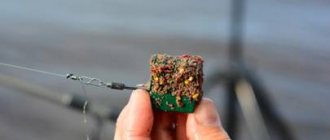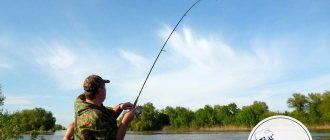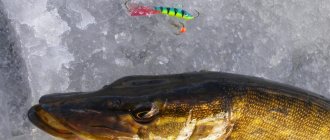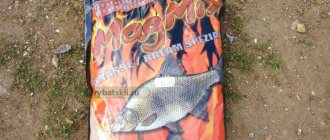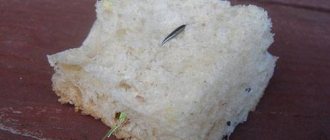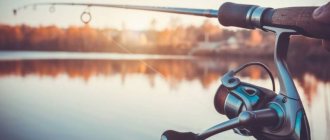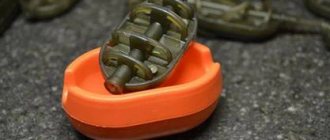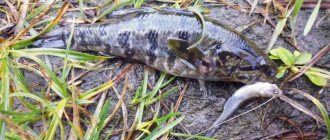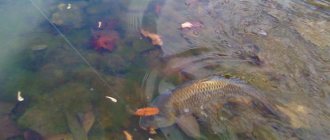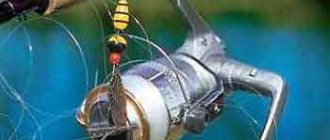Some little-known tricks and unusual techniques that can increase your catches when fishing with a feeder.
Something new and unexplored seems unreal, but when you see it with your own eyes in action on another fisherman, dragging one tail after another, you really believe it! I’ll share some tricky tricks and tricks I’ve learned from other experienced fishermen; I didn’t come up with them myself, so I don’t mind giving them up...
Feeder alarm
An interesting signaling device - I saw a ratchet last summer on the river - I tried it and really liked it. To do this, you will need a plastic tube with an internal diameter greater than the thickness of the nod between the tulip and the subsequent ring. A lollipop stick 8 cm long came up. Using a sharp knife, I cut it lengthwise, carefully spread the slit and put it on the nod behind the tulip. The result is an excellent “bell” that crackles, signaling a bite when you inadvertently distract yourself from watching the nod. At the same time, the alarm does not interfere with casting or fishing at all and significantly enhances the visibility of the nod against different backgrounds, especially dark ones.
Fishing with a feeder near snags
Finding a spot of clean bottom among snags is a big deal! But how many feeders will you tear off before you find that cool penny! About three years ago, one experienced fisherman demonstrated a simple search pattern. Let's say there were some holds at an interesting point on the edge. First of all, we throw at the same distance, but with a lateral shift downstream, first half a meter to the side, a meter, in some cases up to five - until the hooks stop. The fisherman assured that half a meter is usually enough, a maximum of a meter, that is, fishing is carried out practically at the chosen point, the displacement is minimal, and there are no snags. If you can’t get rid of them, then he throws them a little closer, or rather to the same point, but in the process of moving the feeder towards the bottom he makes one or two turns of the reel. If it catches, then it makes 3-4 turns, but at the same time makes sure that the feeder does not completely go over the edge, leaving the place that is interesting to the fish. If this happens, then he throws in the opposite direction - further than the place of the hooks. This technique can also help out when the snag is not very large and spreading. Then all that remains is not to smear it on the found spot.
Video of production of installation of feeder equipment
We highly recommend that you read the reviews of installations of feeder equipment in the following video.
The video shows and describes in some detail the process of making feeder installations, however, beginners may have problems and questions about the nodes. You can get acquainted with some methods of attaching swivels and hooks to fishing line in a special article on knots.
For each type of fish and fishing conditions, a different type of feeder equipment is more suitable, let's take a closer look at each of them.
Fishing on the rapids
A riffle can even be a bream one - I didn’t know about this before, but a couple of years ago I became convinced that on river riffles, even small ones, bream bite well at night and at dawn. Without hiding, one of my acquaintances told me about this, unloading excellent bream caught at night from a cage. He advised fishing not on the crest of the riffle, where the water swirls, forming a noticeable strip almost across the river, but a little further upstream, where deeper, the coastal longitudinal drop running along the riffle is also interesting. He also said that the riffle is good as a visual reference for searching for holes located above and below fifty meters; bream bites in these depressions during the day; large silver bream and ide are mixed in
Fishing off the capes
The high spring bank is good for catching bream, especially where the soil collapses into the river. Large coastal blocks, undermined by spring floods, slide into the water, forming coastal and underwater capes. They are especially promising at river bends, where the cape pushes the current away from the shore - a rip current is clearly visible at the top, and behind it there is a headwater with a return stream. Such places had caressed my gaze before, but I had no idea how to fish here with a feeder. It’s very close to the shore, there are always enough hooks along the breaker stream, and the current is very strong, and at the beginning of the tide the water is finely twisted, twisting even the leash - no swivel can handle it. In general, I knew that it was a good place, but only for a half-bottom or a float rod. But somehow at a similar place I met a fisherman who, with the help of a feeder, got four excellent bream with me. He settled on the same river, but cast just below the border of direct and reverse currents, the cast did not exceed ten meters. Now I don’t miss such points, and I already consider them very feeder.
Homemade feeder stands
A rod stand is a necessary accessory when fishing with a feeder, because you need its correct installation, which facilitates the process of signaling a bite, for which the quiver tip is responsible. If the feeder rod is positioned incorrectly and is not in a stable position, it is impossible to clearly distinguish whether the quivertip is reacting to a fish bite or whether it is swaying due to the wind or waves present in the reservoir.
The feeder stand should be:
- reliable;
- durable;
- height adjustable;
- convenient to use and transport.
You have to fish with a feeder on various types of reservoirs, both on rivers and lakes with standing water, and the versatility of the stand, as well as the ability to adjust for specific conditions, comes to the fore.
In addition, do not forget about resistance to moisture, because a durable metal product without special protection will simply rust, and quite quickly. That part of the feeder stand that is in contact with the fishing rod must be protected with soft materials in order to protect the form from scratches and chips. When a fish bites, the fisherman often has to react quickly and make a hook, so damage to the rod is quite possible and should be avoided.
The most convenient feeder stands are considered to be combs that securely hold the rod even in difficult weather conditions. This stand is made from a piece of dense and elastic EVA material and a regular stand for the butt of a fishing rod, adjustable in height. The main difficulty in making a comb is attaching it to the stand, and a piece of cornice for curtains or curtains will help with this.
To make a comb feeder stand you will need:
- stand for the butt of the rod with a screw thread;
- a piece of EVA material;
- a piece of cornice;
- a screw of a diameter corresponding to the cross-section of the screw connection of the stand and two nuts;
- stationery knife for cutting EVA;
- glue for metal.
In the process of making a comb it is necessary:
- cut a piece of cornice to the appropriate length;
- Make a hole in the central part of the workpiece and secure the screw in it using nuts;
- cut a comb of the required size and configuration from EVA material;
- insert the lower edge of the comb into the cornice fixed to the stand;
- strengthen the structure with glue, the comb stand is ready.
Thanks to the use of a screw connection, the structure can be quickly disassembled during transportation and does not take up much space in a bag or case for racks. It is desirable that the cornice have an anti-corrosion coating that protects against moisture and other negative factors.
To facilitate the assembly of the comb stand, a wrench is used, although this can be done simply and quickly by hand. The use of a cornice strip simplifies the process of fixing EVA, and thanks to gluing, protection is provided against moisture penetration into the structure. The feeder stand is adjustable in height, which allows you to install the comb in a convenient way, for each fishing condition. To increase resistance to moisture, the nuts are varnished or painted with water-repellent paint.
The cost of such a homemade comb is much lower than those sold in fishing stores, but its functionality and reliability are no worse. Having spent very little time, the fisherman makes the required number of comb stands, providing himself with comfort during the fishing session.
If it is necessary to fish at night, the comb is removed from the stand and electronic alarms are attached using a screw connection. Having a homemade comb in stock, the angler solves all problems with installing fishing rods.
Moistening the bait
I used to think that soaking bait was a simple matter, something that had been worked out for a long time, and I had not conducted any experiments in this field. I used classic moderate soaking, thanks to which I got a fairly dense mixture, which began to work slowly - to blur when the feeder was at the bottom. But having become interested in catching crucian carp in the reservoir, I saw that in stagnant water, particularly successful crucian fishermen prepare feeder bait differently. One advanced crucian fisher assured me that soaking methods are as important as the complementary feeding recipes themselves, and in some cases even more important. After all, depending on the amount of water added, baits that are completely different in properties are obtained. That day, this fisherman fed, from my point of view, absolutely inappropriate food, which he called “soup” - a highly moistened mixture, more like a thick porridge. But, unlike real porridge, such a mixture, when the feeder hits the water, immediately forms a thick cloud that gradually settles to the bottom. Thus feeding regularly, the fisherman dragged crucian carp after crucian carp, assuring that in the summer the fish often stand half-water and do not want to sink to the bottom, and you need to catch with a fairly large foam ball, which floats up, thanks to a meter-long leash, to the same height. He also said that such bait works great for crucian carp and tench when fishing from a soft, muddy bottom, into which nothing falls through, and all food particles remain accessible to the fish. Finally, I made a reservation that such a soup for fishing is not suitable for the river - it will instantly be carried away by the current. I listened to him, but did it my way, which I am very glad about, since it was on the river current that I managed to get the bites back when nothing else helped, and it already seemed that the bite was over for today!
And yet, I spied on the same fisherman: he was stirring the bait mixture with his fingers spread wide. I tried this trick myself - it mixes perfectly, thins out the mixture, much better than with cramped fingers, it seems like a trifle, but it turned out to be an effective little discovery. How simple are the solutions to feeder problems? It’s a shame – how could I not have guessed that!?
We make covers for fishing rods
In addition to the problem of storing leashes, fans of feeder fishing have to solve the issue of transporting rods. Even the most reliable and durable feeders are at risk during transportation and hard tube covers are needed to protect them. The stores offer covers for carp and feeder rods, but purchasing them will require additional financial expenses.
A homemade tube in which transportation will be safe will help you avoid expenses. To make such a case, plumbing pipes of the required diameter are used, and the choice depends on the number of fishing rods that are to be transported in the case.
When purchasing a piece of pipe of the required length, you should provide a margin of 15–20 mm, and the bottom of the tube is made of polyethylene caps, available in any household. The bottom is attached using glue or a soldering iron, however, this method will require skills in working with this tool. For those who know how to sew, it will not be difficult to make a fabric case for a tube with a belt and a snake at the top.
A belt is sewn to such a case, and the functionality of the tube increases significantly. Not all fishermen have the opportunity to go fishing by car, and a homemade tube case will provide convenience when transporting rods on the way to the reservoir.
Feeder psychology
Among other things, the fisherman’s psychology also fights against feeder bitelessness, acting in different directions. My partner and I are an eloquent example. My friend is calm, thorough, loves to cover a rich “clearing” for fish, believing that fish will come from afar for good bait, and you need to sit where it is convenient for the fisherman to cast, land and use “killing” techniques. My friend has a lot of them, let’s take, for example, such a cunning trick as a “gas attack” . It is capable of quickly retrieving fish, especially in still water: on the first two or three casts, the feeder is clogged in a special way, and a couple of pinches of concentrated dry powder flavoring are placed between two layers of regular moistened bait. Having reached the bottom, the lure is washed away, and a powerful aromatic explosion occurs, quickly collecting fish or... scaring away everything around, here a lot depends on the choice of a specific aroma, how the local fish treats it, that is, it’s either hit or miss.
Fishing technique
The rods are placed on stands.
Fishing stages:
- The gear is being assembled.
- They set the bait.
- Take the rod in both hands and pass it over your shoulder and behind your back.
- Hold the line near the reel with your index finger
- They make a cast.
- The rod is placed on a stand and the fishing line is reeled in.
- The alarm is attached to the end of the fishing rod.
- A bite is indicated by the bend of the rod.
- Fishing and hooking fish after biting
Feeder rig for fishing in currents
- The weight of the feeder is selected so that it moves easily along the bottom, but is not carried away by the current.
- A long flexible rod is positioned steeply above the water.
- A strong, albeit heavy, reel is better than a light one.
- Braided line is preferable to mono, as it allows you to cast further. Unwinding must be provided within 150 m. Since part of the fishing line or braid quickly fails, a reserve must be provided.
It is recommended to use triangular or square feeders weighing from 30 to 125 g or more, it all depends on the current. The best equipment for fishing in currents is the Gardner Paternoster.
Feeder equipment for fishing in still water
- In stagnant water, the bait remains in the feeder for a long time.
- At close casting distances it is good to fish with a light feeder, up to 3.6 m.
- At distances of about 50 m, a medium one with a length of 4.2 m is suitable.
- The super-heavy class with a length of more than 4 m is used for long casts.
- For standing water, a monofilament line is better suited, as it stretches well and there are fewer slips with such a line.
- Feeders in standing water are often used of open mesh type.
Feeder equipment for bream
In standing water, feeders weighing 50 g are used; a paternoster or an asymmetrical loop is suitable for attaching them.
Hooks select from 10 to 14 numbers. If the ground topography is uneven, it is better to use an oval, freely rolling feed basket.
To catch bream in creeks, use loose feeding with the addition of worms and maggots.
Feeder equipment for crucian carp
- To catch crucian carp, take rods 2.7-4.5 m long, preferably durable ones made of high-modulus graphite.
- Typically, medium-fast or fast rods are suitable for crucian carp.
- Usually, for catching crucian carp, a fishing line with a thickness of 0.2 mm is used, and the leash is even thinner, 012 mm.
- For initial bait, you can use an open feeder made of a large-capacity mesh when fishing on a medium current. The frame type is used if the bottom is muddy.
- The hook must match the color and size of the bait used, as well as the size of the fish. Usually they take hooks No. 8-No. 12.
"Laxative for fish"
He also has his own trump card - “laxative for fish.” A certain additive to the bait actually has some laxative effect, after which the fish’s feeding activity increases, which significantly activates the bite. It works best in the summer heat. Garlic works great as such additives, but you need to work with it carefully, in some places it can scare away fish with its strong aroma, it all depends on the specific body of water. Not very strong pepper is good, for example, I quite successfully tried barbecue seasoning on bream, although this thing can work in two ways, because the fish itself may not like the aroma today, in any case, it’s not worth plopping a lot of seasoning into complementary foods, at most one percent of the total volume. Ordinary wood ash works most reliably, which also has a laxative effect, and it can be added in a decent amount, as long as the necessary mechanical properties of the bait are maintained. A comrade sprinkles two or three handfuls of ash onto half a bucket of moistened, already swollen bait.
I can’t help but admit the benefits of “laxative” additives, but I believe that there should be a system of proven compounds - recklessly pouring all sorts of nonsense into the bait, in a passionate desire to cause “diarrhea” in the fish. You can ruin the entire bait mixture, besides, in my opinion, this is a little tactless in relation to the opponent. My partner just chuckles, assuring that diarrhea is better than constipation...
"Worm puncture"
There is another effective technique - “worm puncture”. My friend’s dung worm works better than others always and everywhere, or so he assures, baiting the dung worm in a special way so that the vigorous liquid of the worm is released evenly little by little, attracting fish for a long time. First, the thick end is pierced, but not all the way through. The hook unfolds and passes along, but not in the center, but closer to the skin, so as not to damage the vital insides of the worm - it will retain mobility longer. The sting is brought out in the center of the body, the worm bends slightly, and the sting is inserted closer to the tail. That's it, the hook is well camouflaged, and at the same time ready to reliably hook the fish if hooked in a timely manner.
In the absence of a bite
With a total lack of bite, the partner begins to experiment with his cunning system and equipment. The first step is to increase the length of the leash: 30 cm, 50, 70, 100, 150. Doesn’t take it? Reduces the diameter of the leader line: 0.20, 0.16, 0.12 mm. He will reduce the size of the hook to No. 18 with the transition to the minimum size of the nozzle - one small maggot, the tail of a worm, cut off with a sharp scalpel - he specially carries it with him. Then he will do the “sandwiches”, going through different combinations of baits, and all the time being confident that the fish will soon bite. And he feeds and feeds, throwing them away at intervals of 5-7, maximum 10 minutes. Only at the evening dawn, when small linen usually disappears, does he change his strategy, switching to a large fish: he shortens the leash to 25-30 cm, increases its thickness to 0.18-0.20 mm, and places a decent-sized hook under a bunch of worm or a few grains of corn. Be sure to make bait with a large number of large particles, and more viscous, so that the feeder is washed out no earlier than after 20-25 minutes, at such intervals, and re-casts, not forgetting, even before dark, to strengthen the fireflies on the tips of the rods, so that you are fully armed meet the “trophy time”.
Perch on a spinner after a rainstorm
Closing of the feeder season
What is better microjig or mormyshing?
Types of feeder equipment
For a small reservoir, you can use a slow or medium action rod with a length of 3.3 meters and a test weight of 40–60 grams.
The fish’s biting activity and catch depend on the correctly selected equipment and the manufacture of the gear.
The rod is specially designed for feeder fishing. It features a large number of rings and a replaceable tip.
But you can also use ordinary spinning rods. The rod is selected depending on the reservoir where fishing will take place.
For a large reservoir and a fast river, a fast action rod with a length of up to 3.9 meters and a weight of 100–120 grams is suitable.
The action will depend on the size of the fish. Slow action is more sensitive to small fish. The reel used is an inertia-free reel, since with its help long casts are obtained, which is important when feeder fishing.
The fishing line is taken with a thickness of 0.2–0.3 mm. It is better to use braid with a diameter of 0.12–0.14 mm.
Leashes with a length of 20 to 60 centimeters are prepared from fishing line 0.18–0.2 mm thick. Bells or electronic bite alarms can be used as a signaling device.
Feeders are available in different types and weights. Its weight should not exceed the second figure in the rod test. Feeders come in the form of cages, spirals, and cones with shifting weights. There are no special requirements for their choice. Each fisherman selects the type of feeder individually.
Before throwing a feeder with fertilizer, it is necessary to study the bottom of the reservoir. Instead of a feeder, attach a lead weight weighing 40 grams, and, throwing it in different places, try to study the bottom. Only after this can you start casting the feeder with bait.
